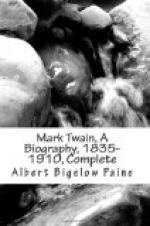It would not be the part of wisdom to attempt another inclusive presentation of Comstock conditions. We may only hope to add a few details of history, justified now by time and circumstances, to supplement the picture with certain data of personality preserved from the drift of years.
XXXVIII
One of the “Staff”
The new reporter found acquaintance easy. The office force was like one family among which there was no line of caste. Proprietors, editors, and printers were social equals; there was little ceremony among them—none at all outside of the office.—["The paper went to press at two in the morning, then all the staff and all the compositors gathered themselves together in the composing-room and drank beer and sang the popular war-songs of the day until dawn.”—S. L. C., in 1908.]—Samuel Clemens immediately became “Sam,” or “Josh,” to his associates, just as De Quille was “Dan” and Goodman “Joe.” He found that he disliked the name of Josh, and, as he did not sign it again, it was presently dropped. The office, and Virginia City generally, quickly grew fond of him, delighting in his originality and measured speech. Enterprise readers began to identify his work, then unsigned, and to enjoy its fresh phrasing, even when it was only the usual local item or mining notice. True to its name and reputation, the paper had added a new attraction.
It was only a brief time after his arrival in Virginia City that Clemens began the series of hoaxes which would carry his reputation, not always in an enviable fashion, across the Sierras and down the Pacific coast. With one exception these are lost to-day, for so far as known there is not a single file of the Enterprise in existence. Only a few stray copies and clippings are preserved, but we know the story of some of these literary pranks and of their results. They were usually intended as a special punishment of some particular individual or paper or locality; but victims were gathered by the wholesale in their seductive web. Mark Twain himself, in his book of Sketches, has set down something concerning the first of these, “The Petrified Man,” and of another, “My Bloody Massacre,” but in neither case has he told it all. “The Petrified Man” hoax was directed at an official named Sewall, a coroner and justice of the peace at Humboldt, who had been pompously indifferent in the matter of supplying news. The story, told with great circumstance and apparent care as to detail, related the finding of a petrified prehistoric man, partially imbedded in a rock, in a cave in the desert more than one hundred miles from Humboldt, and how Sewall had made the perilous five-day journey in the alkali waste to hold an inquest over a man that had been dead three hundred years; also how, “with that delicacy so characteristic of him,” Sewall had forbidden the miners from blasting him from his position. The account further stated




